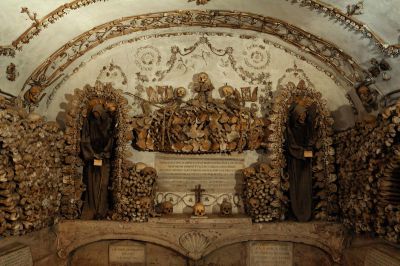What you are now, we once were; what we are now, you shall be
The Capuchins
They were first known as “Friars Minor of the hermetic life,” then later called Capuchins, which comes from the Latin word cappuccio or capuche, for the hood the Friars wear. They embodied a contemplative nature as well as a return to a simpler and more ascetic form of religious life. Much of their time was spent in common and private prayer as well as preaching and taking care of the poor. Their dedication took them to locations where others would not go, exposing themselves to peril, especially during epidemics.
Saint Francis is known as “the universal saint.” He began the Franciscans in 1209, but the Capuchin Franciscan Order was begun in 1528 by Matteo Serafini di Bascio and Brother Ludovico di Fossombrone. It was a reform movement following more rigorously Saint Francis’ ideals: stricter observance of poverty, more preaching, austerity, and service to the poor, sick and suffering.
Stigmata, in Christian mysticism, are bodily marks, scars or pains corresponding to those of the crucified Christ. They are often accompanied by religious ecstasy, the experience of an inner vision of God or a union with the divine. Saint Francis exhibited the first stigmata in 1224, where on Mount Alverna, he had a vision and the five wounds of Jesus Christ on the Cross appeared, the marks of nails in his hands and feet and a red scar on his right side. This greatly enhanced the sanctity of the Franciscan Order and gave it more power.
Saint Padre Pio, noted for his charity and piety, is one of the more renowned Capuchin priests. At age 15, he joined the Capuchin Order. In 1910, the year he became a priest, he received the stigmata on his hands, similar to the wounds suffered by Christ. Although those eventually healed, he received them again in 1918 and they remained with him to his death. That, and the reports of his ability to be in two places at the same time and his gift of healing led to his canonization in 2002.
The Museum
The main purpose of the museum is to make known the spirituality of the Franciscan and Capuchin Orders but it also serves to display and preserve the historic and artistic heritage of the Capuchins of Rome and Lazio. There are eight sections in the museum beginning with the history of the monastery: an explanation of the Order itself, the Capuchin saints, their culture and spirituality displaying liturgical objects, Caravaggio’s painting of “St. Francis in Prayer” depicting him deep in reflection, Capuchins of the XX Century, such as Padre Pio and Mariano of Turin, famous for his TV appearances, and, lastly, the Capuchins’ activities all over the world today. It’s an extensive museum that must be walked through to get to the crypts below and very aptly prepares one for them.
The Crypts
In 1631, when the Capuchin friary of Rome’s Saint Bonaventure was moved to Santa Maria della Concezione, in addition to their personal belongings, the bones of 3,700 dead monks were transported and arranged along the walls in niches, vaults and made into ceiling ornaments. There is no person to either vilify or praise for these eerie designs because there is no documentation that has survived. The Capuchin Crypts are comprised of six tiny chapels or crypts, including the Crypt of the Three Skeletons, the Crypt of Tibias and Femurs, the Crypt of Pelvises, and the Crypt of Skulls. By learning the in-depth history of the Capuchin Order, one can understand more deeply that the Crypts are not meant to be macabre but more a subtle reminder of our own mortality and a realization of how short our time on earth really is. A plaque in the crypt reads, “What you are now, we once were; what we are now, you shall be.”
The Church
In 1631, Santa Maria della Concezione was the first Roman church to be dedicated “To God in honor of the Immaculate Conception of the Blessed Virgin Mary.” The church is decorated with many major works of art commissioned from leading artists of that day: Guido Reni’s “Archangel Michael”, Baccio Carpi’s “Jesus Praying in the Garden of Olives”, and Lionello Spada’s “St. John the Evangelist,” to name a few. The altar piece depicting “Our Lady of the Assumption” and other canvases were brought here from the Saint Bonaventure monastery. St. Felix, the first Capuchin saint, is buried there along with St. Crispin and the remains of Father Mariano. The tomb of Capuchin Cardinal Antonio Berberini is on the floor in front of the high altar.
Over 100 Capuchins have been recognized as saints, having lived a life in imitation of Jesus Christ and having fulfilled all the requirements, after their deaths, of a saint. Today, the Capuchins are one of the largest and most popular orders of the Catholic Church, numbering about 10,500 worldwide. A visit to the Capuchin Museum, crypts and church will change your perspective on those who are living a life of service to the living and honoring those who have passed.
-
 Ceiling Ornament in...
Ceiling Ornament in...
Ceiling Ornament in...
Ceiling Ornament in...
-
 The High Altar...
The High Altar...
The High Altar...
The High Altar...
-
 Crypt of the...
Crypt of the...
Crypt of the...
Crypt of the...
-
 Left: Palermo, Secondo...
Left: Palermo, Secondo...
Left: Palermo, Secondo...
Left: Palermo, Secondo...
-
 Saint Francis in...
Saint Francis in...
Saint Francis in...
Saint Francis in...
-
 Greve in Chianti
Greve in Chianti
Greve in Chianti
Greve in Chianti
https://www.lagazzettaitaliana.com/photo-exhibit/10361-the-capuchins-and-their-crypts#sigProId01ed1adaa4



